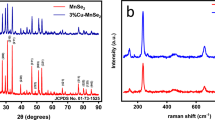Abstract
The cycling performance of Si-nanoparticle/Li cells with different electrolytes has been investigated. Cells containing standard binary LiPF6/ethylene carbonate/ethyl methyl carbonate electrolytes have poor capacity retention (46 %) after 50 cycles. Cells cycled with fluoroethylene carbonate (FEC)-based electrolyte have much better capacity retention (74 %). The effect of incorporation of flame-retardant co-solvents triphenyl phosphate and dimethyl methylphosphonate was investigated with both the standard and FEC electrolytes. The incorporation of the FR co-solvents did not significantly alter the performance of either electrolyte. Ex situ analysis via scanning electron microscopy, attenuated total reflectance infrared spectroscopy, and X-ray photoelectron spectroscopy was conducted to gain a better understanding of the role of electrolyte in solid electrolyte interphase structure and stability.






Similar content being viewed by others
References
Linden D, Reddy TB (2002) Handbook of batteries, 3rd edn. McGraw-Hill, New York
Xu K (2004) nonaqueous liquid electrolytes for lithium-based rechargeable batteries. Chem Rev 104:4303–4418. doi:10.1021/cr030203g
Kasavajjula U, Wang C, Appleby AJ (2007) Nano- and bulk-silicon-based insertion anodes for lithium-ion secondary cells. J Power Sources 163:1003–1039. doi:10.1016/j.jpowsour.2006.09.084
Dalavi S, Guduru P, Lucht BL (2012) Performance enhancing electrolyte additives for lithium ion batteries with silicon anodes. J Electrochem Soc 159:A642–A646. doi:10.1149/2.076205jes
Obrovac MN, Krause LJ (2007) Reversible cycling of crystalline silicon powder. J Electrochem Soc 154:A103–A108. doi:10.1149/1.2402112
Xiao J, Xu W, Wang D et al (2010) Stabilization of Silicon anode for Li-ion batteries. J Electrochem Soc 157:A1047–A1051. doi:10.1149/1.3464767
Liu W-R, Guo Z-Z, Young W-S et al (2005) Effect of electrode structure on performance of Si anode in Li-ion batteries: Si particle size and conductive additive. J Power Sources 140:139–144. doi:10.1016/j.jpowsour.2004.07.032
Nguyen CC, Choi H, Song S-W (2013) Roles of oxygen and interfacial stabilization in enhancing the cycling ability of silicon oxide anodes for rechargeable lithium batteries. J Electrochem Soc 160:A906–A914. doi:10.1149/2.118306jes
Chen L, Wang K, Xie X, Xie J (2006) Enhancing electrochemical performance of silicon film anode by vinylene carbonate electrolyte additive. Electrochem Solid State Lett 9:A512–A512. doi:10.1149/1.2338771
Nie M, Abraham DP, Seo DM et al (2013) Silicon solid electrolyte interphase (SEI) of lithium ion battery characterized by microscopy and spectroscopy. J Phys Chem C 117:13403–13412. doi:10.1021/jp404155y
Smart MC (1999) Electrolytes for low-temperature lithium batteries based on ternary mixtures of aliphatic carbonates. J Electrochem Soc 146:486–492. doi:10.1149/1.1391633
Xu K, Ding MS, Zhang S et al (2002) An attempt to formulate nonflammable lithium ion electrolytes with alkyl phosphates and phosphazenes. J Electrochem Soc 149:A622–A626. doi:10.1149/1.1467946
Dalavi S, Xu M, Ravdel B et al (2010) Nonflammable electrolytes for lithium-ion batteries containing dimethyl methylphosphonate. J Electrochem Soc 157:A1113–A1120. doi:10.1149/1.3473828
Dunn RP, Kafle J, Krause FC et al (2012) Electrochemical analysis of Li-ion cells containing triphenyl phosphate. J Electrochem Soc 159:A2100–A2108. doi:10.1149/2.081212jes
Dunn RP, Nadimpalli SPV, Guduru P, Lucht BL (2013) Flame retardant co-solvent incorporation into lithium-ion coin cells with thin-film Si anodes. J Electrochem Soc 161:A176–A182. doi:10.1149/2.086401jes
Izquierdo-Gonzales S, Li W, Lucht BL (2004) Hexamethylphosphoramide as a flame retarding additive for lithium-ion battery electrolytes. J Power Sources 135:291–296. doi:10.1016/j.jpowsour.2004.04.011
Shim E-G, Nam T-H, Kim J-G et al (2007) Electrochemical performance of lithium-ion batteries with triphenylphosphate as a flame-retardant additive. J Power Sources 172:919–924. doi:10.1016/j.jpowsour.2007.04.088
Smith KA, Smart MC, Prakash GKS, Ratnakumar VB (2009) Lithium-ion electrolytes containing flame-retardant additives for increased safety characteristics. ECS Trans 16:33–41. doi:10.1149/1.3123125
Smart MC, Krause FC, Hwang C et al (2011) The evaluation of triphenyl phosphate as a flame retardant additive to improve the safety of lithium-ion battery electrolytes. ECS Trans 35:1–11. doi:10.1149/1.3646164
Shim E-G, Nam T-H, Kim J-G et al (2007) Effects of functional electrolyte additives for Li-ion batteries. J Power Sources 172:901–907. doi:10.1016/j.jpowsour.2007.04.089
Hyung YE, Vissers DR, Amine K (2003) Flame-retardant additives for lithium-ion batteries. J Power Sources 119–121:383–387. doi:10.1016/S0378-7753(03)00225-8
Xiang HF, Jin QY, Chen CH et al (2007) Dimethyl methylphosphonate-based nonflammable electrolyte and high safety lithium-ion batteries. J Power Sources 174:335–341. doi:10.1016/j.jpowsour.2007.09.025
Xiang HF, Xu HY, Wang ZZ, Chen CH (2007) Dimethyl methylphosphonate (DMMP) as an efficient flame retardant additive for the lithium-ion battery electrolytes. J Power Sources 173:562–564. doi:10.1016/j.jpowsour.2007.05.001
Feng JK, Ai XP, Cao YL, Yang HX (2008) Possible use of non-flammable phosphonate ethers as pure electrolyte solvent for lithium batteries. J Power Sources 177:194–198. doi:10.1016/j.jpowsour.2007.10.084
Wang X, Yasukawa E, Kasuya S, Properties IF (2001) Nonflammable trimethyl phosphate solvent-containing electrolytes for lithium-ion batteries: I. Fundamental properties. J Electrochem Soc 148:A1058–A1065. doi:10.1149/1.1397773
Buqa H, Holzapfel M, Krumeich F et al (2006) Study of styrene butadiene rubber and sodium methyl cellulose as binder for negative electrodes in lithium-ion batteries. J Power Sources 161:617–622. doi:10.1016/j.jpowsour.2006.03.073
Nakai H, Kubota T, Kita A, Kawashima A (2011) Investigation of the solid electrolyte interphase formed by fluoroethylene carbonate on Si electrodes. J Electrochem Soc 158:A798–A798. doi:10.1149/1.3589300
Etacheri V, Haik O, Goffer Y et al (2011) Effect of fluoroethylene carbonate (FEC) on the performance and surface chemistry of Si-nanowire Li-ion battery anodes. Langmuir 28:965–976. doi:10.1021/la203712s
Koo B, Kim H, Cho Y et al (2012) A highly cross-linked polymeric binder for high-performance silicon negative electrodes in lithium ion batteries. Angew Chem Int Ed 51:8762–8767. doi:10.1002/anie.201201568
Zhuang GV, Yang H, Blizanac B, Ross PN (2005) A study of electrochemical reduction of ethylene and propylene carbonate electrolytes on graphite using ATR-FTIR spectroscopy. Electrochem Solid State Lett 8:A441. doi:10.1149/1.1979327
Socrates G (2001) Infrared and Raman characteristic group frequencies: tables and charts, 3rd edn. Wiley, Chichester
Philippe B, Dedryvère R, Allouche J et al (2012) Nanosilicon electrodes for lithium-ion batteries: interfacial mechanisms studied by hard and soft X-ray photoelectron spectroscopy. Chem Mater 24:1107–1115. doi:10.1021/cm2034195
Acknowledgments
The authors gratefully acknowledge funding from Department of Energy Office of Basic Energy Sciences EPSCoR Implementation award (DE-SC0007074).
Author information
Authors and Affiliations
Corresponding author
Rights and permissions
About this article
Cite this article
Dunn, R.P., Nguyen, C.C. & Lucht, B.L. Flame-retardant co-solvent incorporation into lithium-ion coin cells with Si-nanoparticle anodes. J Appl Electrochem 45, 873–880 (2015). https://doi.org/10.1007/s10800-015-0856-6
Received:
Accepted:
Published:
Issue Date:
DOI: https://doi.org/10.1007/s10800-015-0856-6




